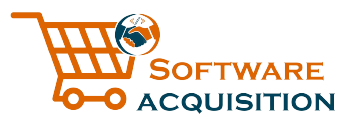Software acquisition is a crucial process for organizations seeking to enhance their business operations and IT strategies. It involves obtaining and integrating software into an organization’s IT infrastructure to support various business functions. From identifying software needs to selecting the optimal solutions, software acquisition plays a vital role in driving innovation, efficiency, and growth.
Key Takeaways:
- Software acquisition refers to the process of obtaining and integrating software into an organization’s IT infrastructure.
- It involves identifying software needs, formulating acquisition strategies, selecting optimal software, and putting it into operation.
- Software acquisition is essential for businesses to streamline operations, improve efficiency, and gain a competitive advantage.
- Organizations should follow best practices, consider total cost of ownership, and implement effective software asset management practices for successful software acquisition.
- Common challenges in software acquisition include accurately defining requirements, managing complex licensing models, and ensuring compatibility with existing systems.
Role of Software Acquisition in Business Operations and IT Strategies
Software acquisition plays a crucial role in enabling businesses to achieve their operational and strategic objectives. By acquiring the right software, organizations can leverage technology to streamline operations, automate processes, improve efficiency, and enhance productivity. This section explores the significance of software acquisition in driving business success and IT strategies.
Software Adoption and Integration
Software adoption involves the integration of new software into existing systems and processes. It allows businesses to leverage the capabilities of innovative technologies and stay ahead of the competition. By adopting new software solutions, organizations can enhance decision-making, optimize workflows, and empower employees with the tools they need to perform their roles effectively.
Software Sourcing and Vendor Selection
Software sourcing refers to the process of identifying and selecting software solutions that align with an organization’s specific needs. It involves evaluating different vendors, considering factors such as functionality, compatibility, scalability, and long-term support. By selecting the right software vendors, organizations can ensure they have access to high-quality solutions that meet their requirements and deliver value in the long run.
Software acquisition is not just a matter of purchasing licenses or subscriptions; it is about strategically aligning technology investments with business goals.
The Benefits of Software Acquisition
Effective software acquisition enables businesses to:
- Improve operational efficiency
- Enhance decision-making and data analysis
- Enable process automation
- Optimize resource allocation
- Streamline collaboration and communication
- Enable scalability and growth
By leveraging the right software solutions, organizations can transform their operations, drive innovation, and gain a competitive edge in the market.

| Key Benefits of Software Acquisition | Key Considerations for Successful Software Acquisition |
|---|---|
| Improved Efficiency | Thorough Research and Evaluation |
| Enhanced Decision-making | Involvement of Key Stakeholders |
| Process Automation | Assessment of Total Cost of Ownership |
| Optimized Resource Allocation | Vendor Reputation and Support |
| Streamlined Collaboration and Communication | Scalability and Compatibility of Software |
| Enable Scalability and Growth | Effective Software Asset Management |
Steps Involved in the Software Acquisition Process
The software acquisition process comprises several essential steps that organizations must follow to ensure a successful acquisition. These steps include:
- Identifying Software Needs and Defining Requirements: This initial step involves understanding the organization’s specific software requirements and clearly defining the functionalities, features, and performance expectations.
- Formulating Acquisition Strategies: Once the software needs are identified, organizations must develop acquisition strategies. This involves deciding whether to develop in-house software, customize existing software, or acquire third-party solutions.
- Conducting Market Research: To make informed software acquisition decisions, organizations must conduct thorough market research. This includes analyzing different software vendors, evaluating their track records, and comparing software solutions.
- Evaluating Software Options: Organizations should carefully evaluate and compare different software options that meet their defined requirements. This evaluation may involve considering factors such as functionality, scalability, user-friendliness, and integration capabilities.
- Negotiating Licenses or Procurement Agreements: After selecting the preferred software solution, organizations must negotiate licensing terms or procurement agreements with the software vendor. This step ensures compliance with licensing requirements and provides clarity on support and maintenance terms.
- Implementing the Software: Once the licenses or agreements are finalized, organizations can proceed with the implementation of the acquired software. This involves customizing the software to align with specific business needs and integrating it into the existing IT infrastructure.
- Managing Software Assets: Effective software asset management is crucial for ensuring compliance, minimizing risks, and optimizing the use of software licenses. This includes maintaining an inventory of software licenses, monitoring usage, and managing updates and patches.
Distinction Between Software Acquisitions and Other IT Acquisitions
It is essential to differentiate software acquisitions from other IT acquisitions due to the unique licensing and deployment considerations of software. Unlike hardware or infrastructure acquisitions, software often requires specific licenses and usage rights. Organizations must also consider software asset management practices to manage licenses effectively and mitigate legal and financial risks.
An illustration depicting the steps involved in the software acquisition process
Key Considerations for Successful Software Acquisition
When it comes to software acquisition, organizations must follow certain best practices to ensure success. By implementing these practices, organizations can maximize the value and benefits of their software acquisitions. Here are some key considerations:
- Thorough Research: Conduct comprehensive research to understand the software market, available options, and industry trends. This research will enable organizations to make informed decisions and select the most suitable software.
- Involvement of Key Stakeholders: Involve key stakeholders throughout the decision-making process. Their expertise and insights will help align the software acquisition with organizational goals and requirements.
- Total Cost of Ownership: Assess the total cost of ownership, including upfront costs, ongoing maintenance and support fees, training expenses, and potential future upgrades or customization requirements. This evaluation will give organizations a clear understanding of the financial implications of the software acquisition.
- Vendor Reputation and Support: Consider the reputation and support services of software vendors. Reliable vendors with a strong track record of providing excellent customer support will ensure a smooth implementation and address any challenges that may arise.
- Scalability and Compatibility: Evaluate the scalability and compatibility of the software with existing systems and future growth plans. It is essential to consider the software’s ability to accommodate changing business needs and integrate seamlessly with other IT infrastructure.
- Effective Software Asset Management: Implement robust software asset management practices to efficiently track, monitor, and optimize software licenses and usage. This ensures compliance with licensing agreements and helps organizations make informed decisions about software renewal, upgrades, or retirement.
By following these best practices, organizations can navigate the software acquisition process effectively and make informed decisions that align with their goals and requirements.
Quote:
“Thorough research, involvement of key stakeholders, and effective software asset management are crucial considerations in the successful acquisition of software.” – [Insert Expert Name], [Insert Expert Title]
Next, we will explore the common challenges faced in the software acquisition process and how organizations can overcome them.

Common Challenges Faced in the Software Acquisition Process
While software acquisition offers numerous benefits, organizations also encounter various challenges throughout the process. These challenges revolve around accurately defining software requirements, managing complex licensing models, ensuring software compatibility with existing systems, managing vendor relationships, and addressing the evolving nature of software technologies. To overcome these challenges, organizations must prioritize proper planning, effective communication, and collaborative strategies.
Defining software requirements accurately
One of the key challenges in the software acquisition process is accurately defining software requirements. It is essential to clearly identify the desired functionality, performance, scalability, and compatibility of the software. Failure to do so can result in selecting software that does not meet the organization’s specific needs, leading to inefficiencies and wasted resources.
Managing complex licensing models
The complex nature of software licensing models poses a significant challenge during software acquisition. Organizations must navigate through various licensing options, understand the terms and conditions, and assess the affordability and scalability of different licensing models. This requires careful analysis and negotiation to ensure compliance and optimize cost-effectiveness.
Ensuring software compatibility with existing systems
Integrating new software with existing systems can be a challenging task. Compatibility issues may arise due to differences in technology, architecture, or data formats. Organizations must thoroughly assess compatibility requirements, conduct extensive testing, and implement appropriate integration strategies to ensure a seamless transition and minimize disruptions.
Managing vendor relationships
Establishing and managing effective vendor relationships is crucial for successful software acquisition. Building trust, clear communication, and solid collaboration with vendors are essential for mutual understanding, timely support, and conflict resolution. Organizations must invest in ongoing vendor management efforts to maintain productive partnerships that contribute to long-term success.
Addressing the evolving nature of software technologies
Software technologies are constantly evolving, presenting a challenge for organizations involved in software acquisition. It is important to stay updated with the latest trends, advancements, and industry standards. Organizations must proactively adapt to emerging technologies, consider future-proof solutions, and invest in continuous learning and development to remain competitive in the digital landscape.
| Challenges | Impact | Solution |
|---|---|---|
| Defining software requirements accurately | Inefficient software selection leading to wasted resources | Thoroughly analyze and document requirements, involve key stakeholders, and conduct thorough research |
| Managing complex licensing models | Potential compliance issues and suboptimal cost-effectiveness | Negotiate and choose appropriate licensing options, assess long-term affordability and scalability |
| Ensuring software compatibility with existing systems | Integration issues, disruptions to business operations | Conduct compatibility assessments, extensive testing, and implement effective integration strategies |
| Managing vendor relationships | Limited support, conflicts, delays in addressing issues | Establish clear communication, build trust, collaborate effectively, and invest in ongoing vendor management |
| Addressing the evolving nature of software technologies | Risk of falling behind competitors, outdated technology | Stay updated with industry trends, invest in continuous learning, and adapt to emerging technologies |
Summary of Software Acquisition Meaning and Best Practices
Software acquisition is a crucial process for organizations seeking to optimize their business operations and IT strategies. It involves a systematic approach to identifying, selecting, and implementing software solutions that align with the organization’s specific needs and objectives. By following best practices and addressing the challenges associated with software acquisition, organizations can leverage software to drive innovation, enhance efficiency, and facilitate growth.
Software acquisition can be defined as the process of obtaining and integrating software into an organization’s IT infrastructure. It encompasses various activities, such as identifying software needs, formulating acquisition strategies, evaluating software options, negotiating licenses or procurement agreements, implementing the software, and managing software assets.
In order to ensure a successful software acquisition, organizations should adopt best practices. These include conducting thorough research, involving key stakeholders in the decision-making process, assessing the total cost of ownership, considering vendor reputation and support, evaluating software scalability and compatibility, and implementing effective software asset management practices.
By adhering to these best practices, organizations can maximize the value and benefits of their software acquisitions. They can not only streamline their operations and enhance decision-making capabilities but also gain a competitive advantage in the market. With the right software solutions in place, organizations can propel their growth, drive productivity, and stay ahead in today’s dynamic business landscape.




